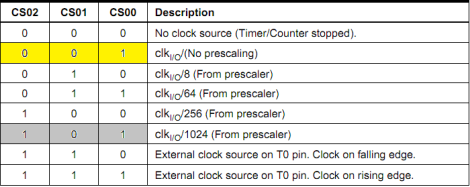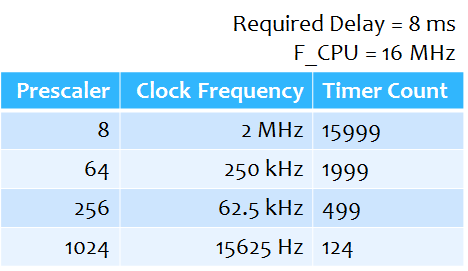Dear readers, please note that this is the old website of maxEmbedded. The articles are now no longer supported, updated and maintained. Please visit the new website here and search for this post. Alternatively, you can remove .wordpress from the address bar to reach the new location.
Example: If the website address is http://maxEmbedded.wordpress.com/contact/, then removing .wordpress from it will become http://maxEmbedded.com/contact/.
We apologize for the inconvenience. We just want to give you a better viewing and learning experience! Thanks!
Hello friends! Welcome back to the second part of the AVR Timers Series. In the previous post, we have discussed the basic concepts of AVR Timers. Let me summarize it:
- We have seen how timers are made up of registers, whose value automatically increases/decreases. Thus, the terms timer/counter are used interchangeably.
- In AVR, there are three types of timers – TIMER0, TIMER1 and TIMER2. Of these, TIMER1 is a 16-bit timer whereas others are 8-bit timers.
- We have seen how prescalers are used to trade duration with resolution.
- We have also discussed how to choose an appropriate value of a prescaler.
- And then, to finish off, we learnt about interrupts.
So, I will move towards its implementation directly. I have assumed that you have understood the concepts discussed above.
In this tutorial, we will learn to use TIMER0. Since timer is a peripheral, it can be activated by setting some bits in some registers. Instead of discussing all the registers at once, we will be discussing them as and when necessary. For those who are new to the term ‘register’, they can read about it from this page. To have an idea about AVR Peripherals, view this page (you need to scroll down a bit).
Problem Statement
Let’s define a problem statement for us. The simplest one being the LED flasher. Let’s say, we need to flash an LED every 6 ms and we are have a CPU clock frequency of 32 kHz.
Well, I know that an LED flashing at every 6 ms will be always visible as on by our eye, but I could not find any simpler example which does not include prescalers. Take this as a demonstration.
Methodology
Now, as per the following formula, with a clock frequency of 32 kHz and 8-bit counter, the maximum delay possible is of 8 ms. This is quite low (for us, but not for the MCU). Hence for a delay of 6 ms, we need a timer count of 191. This can easily be achieved with an 8-bit counter (MAX = 255).
 Thus, what we need to do is quite simple. We need to keep a track of the counter value. As soon as it reaches 191, we toggle the LED value and reset the counter. For this, we need the help of the following registers.
Thus, what we need to do is quite simple. We need to keep a track of the counter value. As soon as it reaches 191, we toggle the LED value and reset the counter. For this, we need the help of the following registers.
TCNT0 Register
The Timer/Counter Register – TCNT0 is as follows:
This is where the uint 8-bit counter of the timer resides. The value of the counter is stored here and increases/decreases automatically. Data can be both read/written from this register.
Now we know where the counter value lies. But this register won’t be activated unless we activate the timer! Thus we need to set the timer up. How? Read on…
TCCR0 Register
The Timer/Counter Control Register – TCCR0 is as follows:
Right now, we will concentrate on the highlighted bits. The other bits will be discussed as and when necessary. By selecting these three Clock Select Bits, CS02:00, we set the timer up by choosing proper prescaler. The possible combinations are shown below.
For this problem statement, we choose No Prescaling. Ignore the bits highlighted in grey. We will be using it later in this tutorial. Thus, we initialize the counter as:
TCCR0 |= (1 << CS00);
Please note that if you do not initialize this register, all the bits will remain as zero and the timer/counter will remain stopped.
Thus now we are ready to write a code for this. To learn about I/O port operations in AVR, view this. To know about bit manipulations, view this.
Code
#include <avr/io.h>
void timer0_init()
{
// set up timer with no prescaling
TCCR0 |= (1 << CS00);
// initialize counter
TCNT0 = 0;
}
int main(void)
{
// connect led to pin PC0
DDRC |= (1 << 0);
// initialize timer
timer0_init();
// loop forever
while(1)
{
// check if the timer count reaches 191
if (TCNT0 >= 191)
{
PORTC ^= (1 << 0); // toggles the led
TCNT0 = 0; // reset counter
}
}
}
I guess the code is pretty simple and straightforward. It doesn’t need any explanation. Or maybe one thing needs explanation. In the if statement, I have used
if (TCNT0 >= 191)
instead of
if (TCNT0 == 191)
This is because sometimes due to missed compares or unexpected increment, this condition may never be true. Thus to remain on the safer side, we use ‘>=’ instead of ‘==’.
Problem Statement Redefined
Now let’s change the above problem statement to the following. We need to flash an LED every 8 ms and we have an XTAL of 16 MHz. Well, 8 ms is still low, but it’s good enough for the following illustration.
Methodology – Using Prescalers
Now since the CPU clock frequency is 16 MHz, the maximum time delay that it can measure is 16 μs! But 8 ms (which is quite a small duration for us) is way much larger. So what do we do? Yes, you guessed right (I hope so ;))! We use a prescaler in order to trade duration with resolution. Now the following table summarizes the results of using different prescalers 8, 64, 256 and 1024. See previous tutorial for details.
From the values of the counter, we can easily rule out the top three prescalers as they are above the maximum limit of an 8-bit counter (which is 255). Thus we use a prescaler of 1024. Now refer to the descriptions of clock select bits as shown in the TCCR0 register. Have a look at the selection highlighted in grey. This implements a prescaler of 1024. The rest remains the same. Moving to the coding part, we simply change the initialize function and the compare value. The rest remains the same.
Code
#include <avr/io.h>
void timer0_init()
{
// set up timer with prescaler = 1024
TCCR0 |= (1 << CS02)|(1 << CS00);
// initialize counter
TCNT0 = 0;
}
int main(void)
{
// connect led to pin PC0
DDRC |= (1 << 0);
// initialize timer
timer0_init();
// loop forever
while(1)
{
// check if the timer count reaches 124
if (TCNT0 >= 124)
{
PORTC ^= (1 << 0); // toggles the led
TCNT0 = 0; // reset counter
}
}
}
Problem Statement Redefined Again!
Now let’s change the problem statement to something you can actually see! Let’s flash an LED every 50 ms (you can surely see the LED flashing this time ;)). We have an XTAL of 16 MHz.
Methodology – Using Interrupts
So now, we have to flash the LED every 50 ms. With CPU frequency 16 MHz, even a maximum delay of 16.384 ms can be achieved using a 1024 prescaler. So what do we do now? Well, we use interrupts.
The concept here is that the hardware generates an interrupt every time the timer overflows. Since the required delay is greater than the maximum possible delay, obviously the timer will overflow. And whenever the timer overflows, an interrupt is fired. Now the question is how many times should the interrupt be fired?
For this, let’s do some calculation. Let’s choose a prescaler, say 256. Thus, as per the calculations, it should take 4.096 ms for the timer to overflow. Now as soon as the timer overflows, an interrupt is fired and an Interrupt Service Routine (ISR) is executed. Now,
50 ms ÷ 4.096 ms = 12.207
Thus, in simple terms, by the time the timer has overflown 12 times, 49.152 ms would have passed. After that, when the timer undergoes 13th iteration, it would achieve a delay of 50 ms. Thus, in the 13th iteration, we need a delay of 50 – 49.152 = 0.848 ms. At a frequency of 62.5 kHz (prescaler = 256), each tick takes 0.016 ms. Thus to achieve a delay of 0.848 ms, it would require 53 ticks. Thus, in the 13th iteration, we only allow the timer to count up to 53, and then reset it. All this can be achieved in the ISR as follows:
// global variable to count the number of overflows
volatile uint8_t tot_overflow;
// TIMER0 overflow interrupt service routine
// called whenever TCNT0 overflows
ISR(TIMER0_OVF_vect)
{
// keep a track of number of overflows
tot_overflow++;
}
int main(void)
{
// connect led to pin PC0
DDRC |= (1 << 0);
// initialize timer
timer0_init();
// loop forever
while(1)
{
// check if no. of overflows = 12
if (tot_overflow >= 12) // NOTE: '>=' is used
{
// check if the timer count reaches 53
if (TCNT0 >= 53)
{
PORTC ^= (1 << 0); // toggles the led
TCNT0 = 0; // reset counter
tot_overflow = 0; // reset overflow counter
}
}
}
}
Please note that the code is not yet ready. Not until you learn how to enable the interrupt feature. For this, you should be aware of the following registers.
TIMSK Register
The Timer/Counter Interrupt Mask – TIMSK Register is as follows. It is a common register for all the three timers. For TIMER0, bits 1 and 0 are allotted. Right now, we are interested in the 0th bit TOIE0. Setting this bit to ‘1’ enables the TIMER0 overflow interrupt.
TIFR Register
The Timer/Counter Interrupt Flag Register– TIFR is as follows. Even though we are not using it in our code, you should be aware of it.
This is also a register shared by all the timers. Even here, bits 1 and 0 are allotted for TIMER0. At present we are interested in the 0th bit TOV0 bit. This bit is set (one) whenever TIMER0 overflows. This bit is reset (zero) whenever the Interrupt Service Routine (ISR) is executed. If there is no ISR to execute, we can clear it manually by writing one to it.
In this example, since we are using ISR, we need not care about this bit (thus this register as a whole).
Enabling Global Interrupts
In the AVRs, there’s only one single bit which handles all the interrupts. Thus, to enable it, we need to enable the global interrupts. This is done by calling a function named sei(). Don’t worry much about it, we simply need to call it once, that’s all.
Final Code
#include <avr/io.h>
#include <avr/interrupt.h>
// global variable to count the number of overflows
volatile uint8_t tot_overflow;
// initialize timer, interrupt and variable
void timer0_init()
{
// set up timer with prescaler = 256
TCCR0 |= (1 << CS02);
// initialize counter
TCNT0 = 0;
// enable overflow interrupt
TIMSK |= (1 << TOIE0);
// enable global interrupts
sei();
// initialize overflow counter variable
tot_overflow = 0;
}
// TIMER0 overflow interrupt service routine
// called whenever TCNT0 overflows
ISR(TIMER0_OVF_vect)
{
// keep a track of number of overflows
tot_overflow++;
}
int main(void)
{
// connect led to pin PC0
DDRC |= (1 << 0);
// initialize timer
timer0_init();
// loop forever
while(1)
{
// check if no. of overflows = 12
if (tot_overflow >= 12) // NOTE: '>=' is used
{
// check if the timer count reaches 53
if (TCNT0 >= 53)
{
PORTC ^= (1 << 0); // toggles the led
TCNT0 = 0; // reset counter
tot_overflow = 0; // reset overflow counter
}
}
}
}
So friends, we are done with the basics of TIMER0. What remains to be discussed in it are CTC Mode and PWM Mode. We will be discussing them in upcoming posts. In the next post, we will discuss how to apply the same concepts to use TIMER1, and then to TIMER2.
Till then, enjoy flashing LEDs at different intervals! 😉
And please comment below to encourage me to keep on updating interesting stuffs! 🙂 Also you can grab the RSS Feeds or subscribe to my blog to stay updated!
Thank You!








sir, i the above post
“For this, let’s do some calculation. Let’s choose a prescaler, say 256. Thus, as per the calculations, it should take 4.096 ms for the timer to overflow. Now as soon as the timer overflows, an interrupt is fired and an Interrupt Service Routine (ISR) is executed.”
how 4.096 ms came….i tried using above formula but i dint get the solution….please help
F_CPU = 16 MHz
Prescaler = 256
New Freq = 16M/256 = 62.5 kHz
New Time Period = 1/62.5k = 0.016 ms
Time to overflow = 256*0.016 = 4.096 ms (Answer)
Simple calculation! Why do you even need a formula for that?!
sir what to do if I need to have two ISR in a code i.e one for TOIE0 and another for OCIE0 , how to declare the two ISR’s seperately…???
Hello Pranjal,
You can enable two interrupts, but you’ll need to specify the separate vectors for them.
For
OCIE0, the vector name isTIMER0_COMP_vectFor
TOIE0, the vector name isTIMER0_OVF_vectNote that this is for ATMega16/32. For vector names for other AVR microcontrollers, refer to this guide.
sir ,
i am working on a project to measure the rpm of a wheel by a hall effect sensor. for that i need to use timers. can u suggest me a code of timers which runs for say 1 minute.
Please read through all my timer tutorials.